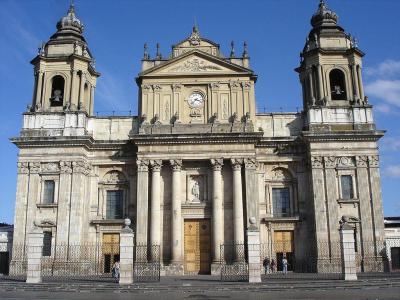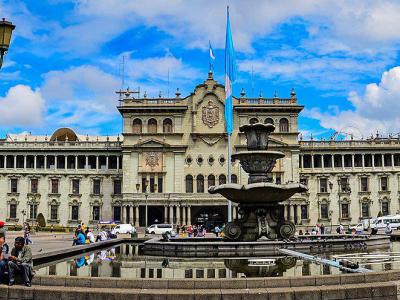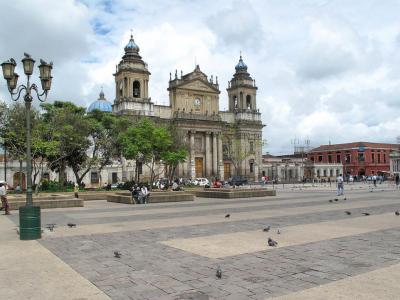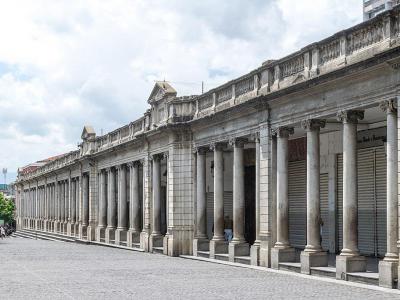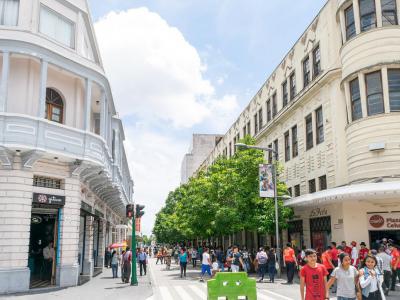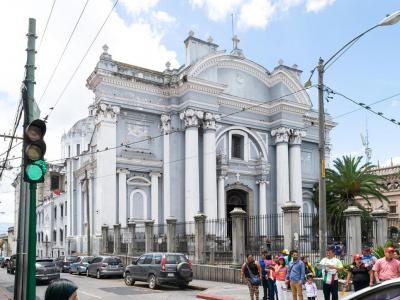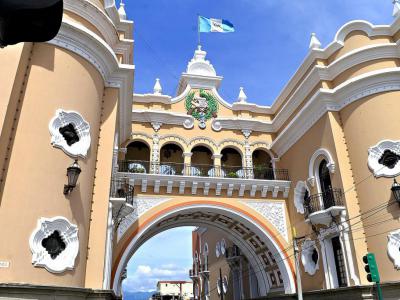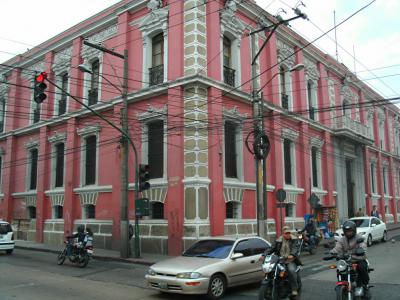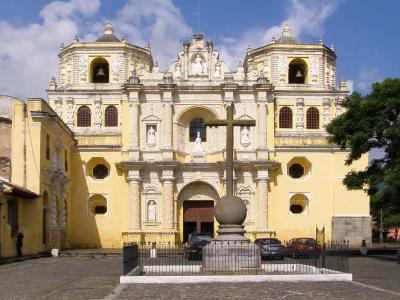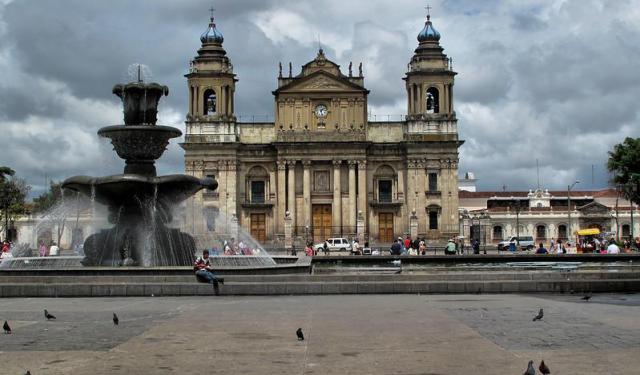
Guatemala City Introduction Walking Tour (Self Guided), Guatemala City
Guatemala City is the capital city of Guatemala and the largest city in Central America. The history of the city dates to 1500 BC when the land was part of the Mayan civilization. The city was known as Kaminaljuyu, which collapsed for unknown causes around 300 AD.
Guatemala City as it stands today was established in 1776 following the Spanish conquest as the capital of the Kingdom of Guatemala. Spanish conquistado Pedro de Alvarado declared the land for Spain and established a small town near the old ruins of Kaminaljuyu. The Cathedral of Guatemala, now a popular tourist attraction, was built at this time.
Guatemala was a member of the Kingdom of Guatemala for nearly 330 years. This kingdom included a part of Mexico, and present-day nations Guatemala, El Salvador, Honduras, Nicaragua and Costa Rica. The kingdom became independent from Spain in 1821. In 1841, Guatemala declared itself an independent republic and retained Guatemala City as its capital.
Guatemala City is the cultural and economic center for the country, which makes it an excellent choice for a visit. The city boasts numerous museums and historical places. Some of these include the National Palace of Culture, San Francisco Church and the National History Museum.
Shopping is a popular activity for tourists to the city. Local markets offer wonderful opportunities to interact with locals, find great souvenirs and sample traditional cuisine.
Guatemala City is ideal for those who love exploring on foot. The city's relatively high altitude moderates average temperatures. Its climate is almost springlike throughout the course of the year, which makes sightseeing on foot a pleasant activity.
Take this self-guided walking tour to see the most memorable attractions in Guatemala City.
Guatemala City as it stands today was established in 1776 following the Spanish conquest as the capital of the Kingdom of Guatemala. Spanish conquistado Pedro de Alvarado declared the land for Spain and established a small town near the old ruins of Kaminaljuyu. The Cathedral of Guatemala, now a popular tourist attraction, was built at this time.
Guatemala was a member of the Kingdom of Guatemala for nearly 330 years. This kingdom included a part of Mexico, and present-day nations Guatemala, El Salvador, Honduras, Nicaragua and Costa Rica. The kingdom became independent from Spain in 1821. In 1841, Guatemala declared itself an independent republic and retained Guatemala City as its capital.
Guatemala City is the cultural and economic center for the country, which makes it an excellent choice for a visit. The city boasts numerous museums and historical places. Some of these include the National Palace of Culture, San Francisco Church and the National History Museum.
Shopping is a popular activity for tourists to the city. Local markets offer wonderful opportunities to interact with locals, find great souvenirs and sample traditional cuisine.
Guatemala City is ideal for those who love exploring on foot. The city's relatively high altitude moderates average temperatures. Its climate is almost springlike throughout the course of the year, which makes sightseeing on foot a pleasant activity.
Take this self-guided walking tour to see the most memorable attractions in Guatemala City.
How it works: Download the app "GPSmyCity: Walks in 1K+ Cities" from Apple App Store or Google Play Store to your mobile phone or tablet. The app turns your mobile device into a personal tour guide and its built-in GPS navigation functions guide you from one tour stop to next. The app works offline, so no data plan is needed when traveling abroad.
Guatemala City Introduction Walking Tour Map
Guide Name: Guatemala City Introduction Walking Tour
Guide Location: Guatemala » Guatemala City (See other walking tours in Guatemala City)
Guide Type: Self-guided Walking Tour (Sightseeing)
# of Attractions: 10
Tour Duration: 2 Hour(s)
Travel Distance: 3.0 Km or 1.9 Miles
Author: sabrina
Sight(s) Featured in This Guide:
Guide Location: Guatemala » Guatemala City (See other walking tours in Guatemala City)
Guide Type: Self-guided Walking Tour (Sightseeing)
# of Attractions: 10
Tour Duration: 2 Hour(s)
Travel Distance: 3.0 Km or 1.9 Miles
Author: sabrina
Sight(s) Featured in This Guide:
- Cathedral of Guatemala City
- National Palace of Culture
- Plaza de la Constitución (Central Park)
- Portal del Comercio (Gate of Commerce)
- Paseo de la Sexta (Walk of the Sixth)
- San Francisco Church
- Guatemala Post Office Building
- National History Museum
- La Merced Church
- Central Market
1) Cathedral of Guatemala City (must see)
The Cathedral of Guatemala is the Archdiocese of Guatemala. It is officially named the Holy Church Cathedral Metropolitan Basilica of Santiago de Guatemala.
The edifice was designed by engineer Joaquin de Isasi, architect Marco Ibanez and artist Antonio Bernasconi. Work on the Cathedral began in 1783. The final piece of the original construction was the sculpture of Our Lady of Perpetual Help, which was moved to the Cathedral of Guatemala from Santa Rosa Chapel in 1815.
The Cathedral incorporates Baroque and Classical architectural styles. The varied elements are due to continued construction and reconstruction over the years. Two towers on the east side were added in 1821, a marble altar was added in 1860, and the bell towers were finished in 1867. The main bell was created from bronze from the San Jose Fort cannons.
The Cathedral of Guatemala was damaged by the devastating earthquake of 1917. Reconstruction was slow, but eventually, the facade was rebuilt. The religious edifice was damaged again by the earthquake of 1976, and its restoration took five years.
The front of the Cathedral is decorated with a series of 12 pillars. The pillars are inscribed with the names of people who were killed during the Guatemalan Civil War.
The Cathedral of Guatemala is located in the Central Park area. Visitors are welcome to tour the inside of the building, which has numerous works of art and religious carvings. It is open daily from 8 AM to 8 PM.
The edifice was designed by engineer Joaquin de Isasi, architect Marco Ibanez and artist Antonio Bernasconi. Work on the Cathedral began in 1783. The final piece of the original construction was the sculpture of Our Lady of Perpetual Help, which was moved to the Cathedral of Guatemala from Santa Rosa Chapel in 1815.
The Cathedral incorporates Baroque and Classical architectural styles. The varied elements are due to continued construction and reconstruction over the years. Two towers on the east side were added in 1821, a marble altar was added in 1860, and the bell towers were finished in 1867. The main bell was created from bronze from the San Jose Fort cannons.
The Cathedral of Guatemala was damaged by the devastating earthquake of 1917. Reconstruction was slow, but eventually, the facade was rebuilt. The religious edifice was damaged again by the earthquake of 1976, and its restoration took five years.
The front of the Cathedral is decorated with a series of 12 pillars. The pillars are inscribed with the names of people who were killed during the Guatemalan Civil War.
The Cathedral of Guatemala is located in the Central Park area. Visitors are welcome to tour the inside of the building, which has numerous works of art and religious carvings. It is open daily from 8 AM to 8 PM.
2) National Palace of Culture (must see)
The National Palace of Culture is a museum built as the headquarters of the President of Guatemala.
In 1921, President Carlos Herrera ordered the construction of the Centenary Palace in only three months with a small budget and few resources. The first palace became known as the Cardboard Palace (Palacio de Carton). It was destroyed in a fire in 1925.
Construction of the current palace began in 1939 and was completed in 1943. The building, designed by architect Rafael Perez de Leon, features Spanish Baroque and Spanish Renaissance architectural styles. Engineers Enrique Reyes, Luis Angel Rodas, and Arturo Bickford assisted with the structural plans. Due to its structural integrity, it was one of the few buildings to survive the earthquake of 1976.
The brick and concrete building is sometimes referred to as The Big Guacamole due to the oxidized copper coating on the exterior. This coating was chosen because green was the favorite color of Marta Lainfiesta Dorion, wife of president Jorge Ubico.
The interior of the palace has 350 rooms with ornate decorations. Large chandeliers and images of quetzals, the national bird of Guatemala, are located throughout the building. Several traffic lights are located in the palace. These were used to signal when the president was in the building, when only government officials were allowed in hallways and when visitors could move freely.
The palace was fully renovated in 2010.
In 1921, President Carlos Herrera ordered the construction of the Centenary Palace in only three months with a small budget and few resources. The first palace became known as the Cardboard Palace (Palacio de Carton). It was destroyed in a fire in 1925.
Construction of the current palace began in 1939 and was completed in 1943. The building, designed by architect Rafael Perez de Leon, features Spanish Baroque and Spanish Renaissance architectural styles. Engineers Enrique Reyes, Luis Angel Rodas, and Arturo Bickford assisted with the structural plans. Due to its structural integrity, it was one of the few buildings to survive the earthquake of 1976.
The brick and concrete building is sometimes referred to as The Big Guacamole due to the oxidized copper coating on the exterior. This coating was chosen because green was the favorite color of Marta Lainfiesta Dorion, wife of president Jorge Ubico.
The interior of the palace has 350 rooms with ornate decorations. Large chandeliers and images of quetzals, the national bird of Guatemala, are located throughout the building. Several traffic lights are located in the palace. These were used to signal when the president was in the building, when only government officials were allowed in hallways and when visitors could move freely.
The palace was fully renovated in 2010.
3) Plaza de la Constitución (Central Park)
Plaza de la Constitucion (Constitution Square) is the largest square in Guatemala. It is also known as Plaza de las Ninas (Girls' Square), Guy Urban Park, or, most often, Central Park. Central Park is surrounded by the National Palace of Culture, the Cathedral of Guatemala City, the Gate of Commerce, and the National Library of Guatemala.
Central Park was created in 1776 to accompany the cathedral. The areas that now hold some of the most important buildings in the country were gardens and shopping arcades. Though the buildings were added around the site over the years, the square itself remained mostly untouched until the late 19th century when a beautification project was championed by President Jose Maria Reyna Barrios.
Since the square's construction, it has been an important part of the history of the country. Guerilla attacks in the 1980s and tragic lynchings in the 1920s are some of the darkest events that have taken place in the square. However, it is also the location of celebrations, parades, and concerts.
Today, visitors will see a space that is catered to tourists. There are numerous shaded spots to rest, food carts, and souvenir stands. The square is open daily.
Central Park was created in 1776 to accompany the cathedral. The areas that now hold some of the most important buildings in the country were gardens and shopping arcades. Though the buildings were added around the site over the years, the square itself remained mostly untouched until the late 19th century when a beautification project was championed by President Jose Maria Reyna Barrios.
Since the square's construction, it has been an important part of the history of the country. Guerilla attacks in the 1980s and tragic lynchings in the 1920s are some of the darkest events that have taken place in the square. However, it is also the location of celebrations, parades, and concerts.
Today, visitors will see a space that is catered to tourists. There are numerous shaded spots to rest, food carts, and souvenir stands. The square is open daily.
4) Portal del Comercio (Gate of Commerce)
The Gate of Commerce, or Portal del Comercio, is a trade center in Guatemala City. The building is home to several vendors who sell shoes, clothing, furniture, electronics, and food, among many other items.
The history of the Gate of Commerce dates to 1788. It was used by the wealthiest families, as a location for trade. Once the shops were installed, they became more widely used by the general public. However, it was still primarily used by the wealthy because of the high-quality stores. It was also the location of the customs office, the Royal Post Office, and the Royal Tobacco Department.
A common story about the Gate of Commerce is that one of the first stores sold women's underwear. It was considered a great scandal at the time. It is said that many families refused to let their daughters pass in front of the building where underwear was on display.
The building was designed by architect Luis Monzon. The earthquake of 1917, which destroyed many buildings in Guatemala City, caused it to collapse. Reconstruction took place in 1924 with its new Colonial and Neoclassical styles.
The history of the Gate of Commerce dates to 1788. It was used by the wealthiest families, as a location for trade. Once the shops were installed, they became more widely used by the general public. However, it was still primarily used by the wealthy because of the high-quality stores. It was also the location of the customs office, the Royal Post Office, and the Royal Tobacco Department.
A common story about the Gate of Commerce is that one of the first stores sold women's underwear. It was considered a great scandal at the time. It is said that many families refused to let their daughters pass in front of the building where underwear was on display.
The building was designed by architect Luis Monzon. The earthquake of 1917, which destroyed many buildings in Guatemala City, caused it to collapse. Reconstruction took place in 1924 with its new Colonial and Neoclassical styles.
5) Paseo de la Sexta (Walk of the Sixth)
The Walk of the Sixth, or Paseo de la Sexta, is a portion of Sixth Avenue populated with restaurants, cafes, bars, and shopping spots. The area is popular with tourists and locals due to its variety of shops and central location.
The street was created with the plan for cultural activities, but it is now primarily a shopping spot. Still, those looking for a cultural experience may find it on the Walk of the Sixth. Local food, craft offerings, and open-air sculptures give tourists a taste of true Guatemala.
Pasaje Rubio (Blonde Alley) is one of the most notable buildings on the street. The yellow brick structure is mostly apartments, but the first floor is home to antique shops, a jewelry store, and a bookstore.
This section of Sixth Avenue was remodeled in 2010. It was turned into a pedestrian-only street so those exploring the tourist attractions nearby, like Central Park and the National Palace of Culture, can continue their walking tour unencumbered by street traffic.
The street was created with the plan for cultural activities, but it is now primarily a shopping spot. Still, those looking for a cultural experience may find it on the Walk of the Sixth. Local food, craft offerings, and open-air sculptures give tourists a taste of true Guatemala.
Pasaje Rubio (Blonde Alley) is one of the most notable buildings on the street. The yellow brick structure is mostly apartments, but the first floor is home to antique shops, a jewelry store, and a bookstore.
This section of Sixth Avenue was remodeled in 2010. It was turned into a pedestrian-only street so those exploring the tourist attractions nearby, like Central Park and the National Palace of Culture, can continue their walking tour unencumbered by street traffic.
6) San Francisco Church
San Francisco Church, or Iglesia San Francisco, is a catholic church completed in 1829. The church is sometimes referred to as the Temple of San Francisco, or Basilica of the Immaculate Conception.
The church blends Neoclassical and Baroque architectural styles. It was designed to resemble the Church of San Francisco El Grande in Antigua Guatemala. The architect was Don Santiago Marqui.
Though the exterior is undoubtedly stunning, the primary feature of the church is the inside. The main wooden altar is nearly 300 feet high and 40 feet wide. The church is also known for its intricate wood carvings of Crucified Jesus and The Passion.
Some furnishings donated by King Carlos V of Spain include a sculpture of the Immaculate Conception, which rests upon the altar.
San Francisco Church fell into ruins after the earthquake of 1917. It was rebuilt in the 1920s before being damaged again in the earthquake of 1976. Engineer Oscar Martinez Diguero led reconstruction efforts. However, parts of the church still show signs of damage.
There is no admission fee to visit this church. It is open daily for tours from 6 AM to 5 PM. Visitors are also welcome to attend mass held daily. The church is managed by the Franciscans, but it belongs to the Archdiocese of Santiago de Guatemala.
The church blends Neoclassical and Baroque architectural styles. It was designed to resemble the Church of San Francisco El Grande in Antigua Guatemala. The architect was Don Santiago Marqui.
Though the exterior is undoubtedly stunning, the primary feature of the church is the inside. The main wooden altar is nearly 300 feet high and 40 feet wide. The church is also known for its intricate wood carvings of Crucified Jesus and The Passion.
Some furnishings donated by King Carlos V of Spain include a sculpture of the Immaculate Conception, which rests upon the altar.
San Francisco Church fell into ruins after the earthquake of 1917. It was rebuilt in the 1920s before being damaged again in the earthquake of 1976. Engineer Oscar Martinez Diguero led reconstruction efforts. However, parts of the church still show signs of damage.
There is no admission fee to visit this church. It is open daily for tours from 6 AM to 5 PM. Visitors are also welcome to attend mass held daily. The church is managed by the Franciscans, but it belongs to the Archdiocese of Santiago de Guatemala.
7) Guatemala Post Office Building
The Guatemala Post Office Building is the general management office for the Guatemalan postal service. Known as the Palacio de Correos in Spanish, it is located in Zone 1 of Guatemala City and is currently home to the Museum of Posts, Telegraphs, and Philately of Guatemala.
Construction on the building began in 1937 and was completed in 1940. It was designed in the Neo-Colonial architectural style, with two buildings linked by an arched pedestrian bridge. That bridge was inspired by the Santa Catalina Arch in Antigua, Guatemala.
Visitors to the museum will see a Postal room with accessories dating to 1932. Items include phones, postcards, and unique stamps, along with a post office motorcycle and bicycle used for distributing mail.
The Telegraphic Room allows visitors to attempt making their telegraphs, while the Philatelic Room is a must for stamp collectors. This room offers an assortment of unique stamps and shows items used over the history of stamp collecting.
The building was declared a National Monument in 1981.
Construction on the building began in 1937 and was completed in 1940. It was designed in the Neo-Colonial architectural style, with two buildings linked by an arched pedestrian bridge. That bridge was inspired by the Santa Catalina Arch in Antigua, Guatemala.
Visitors to the museum will see a Postal room with accessories dating to 1932. Items include phones, postcards, and unique stamps, along with a post office motorcycle and bicycle used for distributing mail.
The Telegraphic Room allows visitors to attempt making their telegraphs, while the Philatelic Room is a must for stamp collectors. This room offers an assortment of unique stamps and shows items used over the history of stamp collecting.
The building was declared a National Monument in 1981.
8) National History Museum
The National History Museum is a French Neo-Renaissance-style building. It is home to a museum with exhibits that focus on the history of Guatemala. It specifically provides insight into the ethnic groups of the region.
The museum was founded in 1976. It was originally located in the National Library, then moved to the National Palace, and was temporarily held in the house of Doctor Robles on Sixth Avenue. It found its current home, in the former building of the Real Property Registry, in 1984.
The building, constructed in 1896, was carefully secured against damage to preserve valuable documents. The walls were reinforced with iron, the ceilings were made with metal mesh, and the staircases were built from marble. A minimal amount of wood was used in the building to protect it against fires.
It was one of the few buildings, that was not destroyed during the earthquake of 1917. However, it was severely damaged. The earthquake of 1976 damaged about 50 percent of the building, which caused the Real Property Registry to vacate. It was decided to demolish the building and turn the land into a parking lot. However, champions of historic buildings led the fight to have it declared, an important national landmark.
The building was restored in 1984 to be used as the National History Museum. It also provides concerts and film screenings; and hosts a library.
The museum was founded in 1976. It was originally located in the National Library, then moved to the National Palace, and was temporarily held in the house of Doctor Robles on Sixth Avenue. It found its current home, in the former building of the Real Property Registry, in 1984.
The building, constructed in 1896, was carefully secured against damage to preserve valuable documents. The walls were reinforced with iron, the ceilings were made with metal mesh, and the staircases were built from marble. A minimal amount of wood was used in the building to protect it against fires.
It was one of the few buildings, that was not destroyed during the earthquake of 1917. However, it was severely damaged. The earthquake of 1976 damaged about 50 percent of the building, which caused the Real Property Registry to vacate. It was decided to demolish the building and turn the land into a parking lot. However, champions of historic buildings led the fight to have it declared, an important national landmark.
The building was restored in 1984 to be used as the National History Museum. It also provides concerts and film screenings; and hosts a library.
9) La Merced Church
La Merced Church is a Catholic temple in Guatemala City. This Baroque-style building has one of the most ornate facades of any Catholic church in Guatemala City, beautifully decorated with religious art and relics.
The church was built in 1540 by the La Merced Order. It was taken over by Jesuits in the early 19th century.
Many of the pieces of art inside the building were brought from the more famous La Merced Church in Antigua Guatemala after it was damaged by earthquakes. Artworks consist of carvings, sculptures, paintings, and statues.
It is worth stopping by the church when it is open to see the interior, which is just as stunning as the building's facade. The church is open from Monday to Thursday from 9 AM to 5 PM with a two-hour closure from noon to 2 PM. It is open on Fridays from 9 AM to noon.
The church was built in 1540 by the La Merced Order. It was taken over by Jesuits in the early 19th century.
Many of the pieces of art inside the building were brought from the more famous La Merced Church in Antigua Guatemala after it was damaged by earthquakes. Artworks consist of carvings, sculptures, paintings, and statues.
It is worth stopping by the church when it is open to see the interior, which is just as stunning as the building's facade. The church is open from Monday to Thursday from 9 AM to 5 PM with a two-hour closure from noon to 2 PM. It is open on Fridays from 9 AM to noon.
10) Central Market (must see)
Central Market (Mercado Central) is an indoor shopping area in Guatemala City. The building offers three levels of shops and food. It's a place for people-watching, looking for souvenirs, or just exploring the shopping scene of Guatemala City.
The Market is located at the rear of the Metropolitan Cathedral. There are many indoor markets in the city, but none are as large and diverse as the Central Market. Vendors at Central Market sell items that range from handmade goods to mass-produced knickknacks, food, and art.
Food items, on the second floor, range from locally-sourced fruits to freshly baked goods. Dining rooms are available for those who want to enjoy a prepared meal or sample a variety of teas, pastries, meats, and cheeses.
The top level of Central Market is the best spot to find artisans hard at work. Tourists can watch basket weavers make their wares before purchasing one to take home. Shoppers will also find handmade jewelry, pottery, and leather items.
Central Market is open daily from 7 AM to 5 PM.
The Market is located at the rear of the Metropolitan Cathedral. There are many indoor markets in the city, but none are as large and diverse as the Central Market. Vendors at Central Market sell items that range from handmade goods to mass-produced knickknacks, food, and art.
Food items, on the second floor, range from locally-sourced fruits to freshly baked goods. Dining rooms are available for those who want to enjoy a prepared meal or sample a variety of teas, pastries, meats, and cheeses.
The top level of Central Market is the best spot to find artisans hard at work. Tourists can watch basket weavers make their wares before purchasing one to take home. Shoppers will also find handmade jewelry, pottery, and leather items.
Central Market is open daily from 7 AM to 5 PM.
Walking Tours in Guatemala City, Guatemala
Create Your Own Walk in Guatemala City
Creating your own self-guided walk in Guatemala City is easy and fun. Choose the city attractions that you want to see and a walk route map will be created just for you. You can even set your hotel as the start point of the walk.
Religious Buildings Walk
Guatemala City's religious scene, while also embracing other faiths, is centered predominantly around Catholicism. The local churches are quite impressive in terms of architecture and are an integral part of the local culture and everyday life. Nestled amid the city's bustling streets and modern architecture, the multiple sacred sites reflect the deep spiritual roots of the Guatemalan... view more
Tour Duration: 1 Hour(s)
Travel Distance: 2.4 Km or 1.5 Miles
Tour Duration: 1 Hour(s)
Travel Distance: 2.4 Km or 1.5 Miles
Guatemala City Culture Venues
Among other things that a tourist may find interesting in Guatemala City are a number of cultural venues, such as museums, that provide an opportunity to discover some important and sometimes curious historical artifacts about the capital of Guatemala.
One such venue is the Guatemala City Railway Museum, located within the former railway station, offering thrilling exhibitions and a wealth of... view more
Tour Duration: 1 Hour(s)
Travel Distance: 1.7 Km or 1.1 Miles
One such venue is the Guatemala City Railway Museum, located within the former railway station, offering thrilling exhibitions and a wealth of... view more
Tour Duration: 1 Hour(s)
Travel Distance: 1.7 Km or 1.1 Miles
The Most Popular Cities
/ view all
